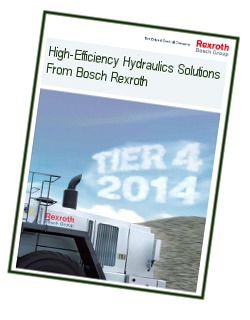 |
| April 17, 2012 | Volume 08 Issue 15 |
Designfax weekly eMagazine
Archives
Partners
Manufacturing Center
Product Spotlight
Modern Applications News
Metalworking Ideas For
Today's Job Shops
Tooling and Production
Strategies for large
metalworking plants
Drive and control hydraulics:
The TIER 4 final challenge for mobile equipment makers
By Terry Hershberger
The final run-up to the complete implementation of TIER 4 regulations has begun. In 2014, TIER 4 final regulations will be in effect, and diesel systems will be required to operate generating near-zero targeted emission levels. These levels are the final reduction from TIER 4 Interim levels, which required emissions to be at 10% of TIER 3 levels for particulate matter (soot) and 50% of nitrous oxide (NOx) levels.

Click here to download "High-Efficiency Hydraulics Solutions from Bosch Rexroth," a really informative, direct-download pdf that covers hydrostatic fan drives, diesel hydraulic controls, energy-efficient excavator controls, hydraulic fly wheels, and more.
This significant reduction will force many mobile equipment manufacturers to fully re-design their systems, from the ground up. And those re-designs can have large impacts on the function of the machine through the drive and control hydraulics, as well as impact the performance, flexibility, and reliability of the mobile equipment.
To be in compliance and fully market ready, postponing is not an option: crucial engineering and design decisions must be made now. If not, manufacturers may be forced to make complex, last-minute changes to mobile equipment design that will increase costs and affect the competitive value of backhoes, cranes, tractors, drilling rigs, and other mobile systems. If that happens, manufacturers also risk creating machines that lack function and power optimization, or incorporate exhaust treatment systems that eat up valuable machine space – not conducive to efficient system design.
The TIER 4 final challenge comes down to this: It can be treated as a regulatory roadblock that adds cost and complexity to the product development process as well as increased operational costs, or it can used as an opportunity to become even more competitive. Now is the time to invest in cutting-edge technology that enables mobile systems to fully comply with TIER 4 final challenges, while delivering the power, performance, and flexibility mobile customers require for their complex, work-intensive applications.
There are several technology challenges, highly inter-related, that will need to be addressed to meet TIER 4 final requirements:
Comprehensive exhaust gas aftertreatment: Starting in 2014, near-zero levels of particulate matter and NOx emissions will be permitted. The combination of exhaust gas treatment and particle filters will have to be optimized. This will increase development outlays and costs, both for components regarding the exhaust gas recirculation system and for additional aftertreatment catalytic reduction systems.
Expanded space requirements: Until now, optimizing the performance of individual components has allowed many machines to remain in compliance. TIER 4's drastic emission reductions are expected to require wholesale re-design, and require exhaust cooling systems that may require 15% to 40% additional space on mobile machines – and for small to medium-size construction machinery, fitting it all in is a major engineering challenge.
Increased cooling requirements: Diesel engines will need to operate in a narrow optimum temperature band to maintain emissions compliance; this places new burdens on diesel cooling systems, reducing peak combustion temperatures, while further reducing the particle content of exhaust gases.
Changed dynamic response of diesel engines: TIER 4 final could have an impact on overall machine performance, if designers choose only to downsize the diesel engine to achieve compliance. However, by also optimizing the transfer of available power with the hydraulic system performance, it's possible to downsize the diesel engine and still achieve identical machine performance.
Higher equipment and operating costs: While there is no question that the new exhaust cooling systems will require mobile equipment re-design, engineering and end-user costs can escalate if a piecemeal approach is taken to solving individual emissions and equipment re-design issues.
As a world leader in mobile hydraulics technologies, Bosch Rexroth has invested continuously in developing technologies to respond to the requirements of TIER 4 final and to equip mobile equipment manufacturers of every type with solutions engineered to sustain equipment performance and competitiveness.
Rather than target one or two specific hydraulics products to the challenge of TIER 4 final compliance, Rexroth has developed a state-of-the-art suite of systems, built on a holistic approach to optimizing energy efficiency and environmental compliance in mobile machines – what we call BlueHydraulics:
- Reduced emission – through intelligent networking and control of both diesel engines and hydraulics components that are ideally matched to operate and call on engine output in an optimal manner.
- Increased efficiency – through optimized individual components such as our A4VG variable pumps that increase overall efficiency, delivering power to hydraulics systems while demanding less power from diesel systems.
- Enhanced energy efficiency – hydraulics components such as Green Valves that provide added functionality while simultaneously making reduced energy consumption possible throughout the system.
 To learn more about our solutions for TIER 4 final, download the latest "High-Efficiency Hydraulics Solutions from Bosch Rexroth" brochure.
To learn more about our solutions for TIER 4 final, download the latest "High-Efficiency Hydraulics Solutions from Bosch Rexroth" brochure.
About the author
Terry Hershberger is director sales, Industry Sector Management, Bosch Rexroth Corporation.
Rate this article
View our terms of use and privacy policy
